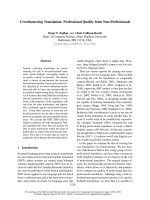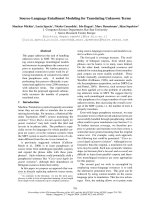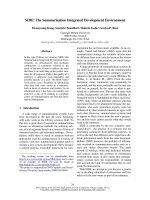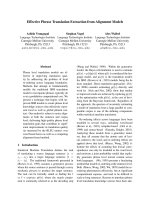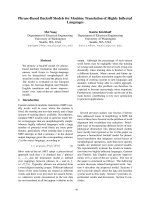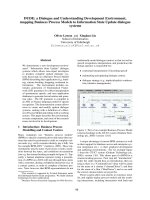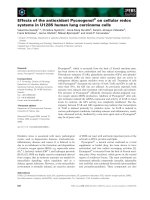báo cáo khoa học: " Effective continuing professional development for translating shared decision making in primary care: A study protocol" docx
Bạn đang xem bản rút gọn của tài liệu. Xem và tải ngay bản đầy đủ của tài liệu tại đây (242.31 KB, 6 trang )
STUD Y PROT O C O L Open Access
Effective continuing professional development for
translating shared decision making in primary
care: A study protocol
France Légaré
1*
, Hilary Bekker
2
, Sophie Desroches
1
, Mary Politi
3
, Dawn Stacey
4
, Francine Borduas
5
,
Francine M Cheater
6
, Jacques Cornuz
7
, Marie-France Coutu
8
, Norbert Donner-Banzhoff
9
, Nora Ferdjaoui-Moumjid
10
, Frances Griffiths
11
, Martin Härter
12
, Cath Jackson
13
, André Jacques
14
, Tanja Krones
15
, Michel Labrecque
1
,
Rosario Rodriguez
16
, Michel Rousseau
17
, Mark Sullivan
18
Abstract
Background: Shared decision making (SDM) is a process by which a healthcare choice is made jointly by the
healthcare professional and the patient. SDM is the essential element of patient-centered care, a core concept of
primary care. However, SDM is seldom translated into primary practice. Continuing professional development (CPD)
is the principal means by which healthcare professionals contin ue to gain, improve, and broaden the knowledge
and skills required for patient-centered care. Our international collaboration seeks to improve the knowledge base
of CPD that targets translating SDM into the clinical practice of primary care in diverse healthcare systems.
Methods: Funded by the Canadian Institutes of Health Research (CIHR), our project is to form an international,
interdisciplinary research team composed of health services researchers, physicians, nurses, psychologists, dietitians,
CPD decision makers and others who will study how CPD causes SDM to be practiced in primary care. We will
perform an environmental scan to create an inventory of CPD programs and related activities for translating SDM
into clinical practice. These programs will be critically assessed and compared according to their strengths and
limitations. We will use the empirical data that results from the environmental scan and the critical appraisal to
identify knowledge gaps and generate a research agenda during a two-day workshop to be held in Quebec City.
We will ask CPD stakeholders to validate these knowledge gaps and the research agenda.
Discussion: This project will analyse existing CPD programs and related activities for translating SDM into the
practice of primary care. Because this international collaboration will develop and identify various factors
influencing SDM, the project could shed new light on how SDM is implemented in primary care.
Background
The importance of addressing decision making in primary
care
Primary health care can be defined as the ‘level of a
health service system that provides entry into the system
for all new needs and problems, provides person-
focused (not disease-oriented) care over t ime, provides
care for all but very uncommon or unusual conditions,
and coordinates or integrates care provided elsewhere or
by others’ [1]. Countries with a strong primary health-
care system can improve their populations’ health out-
comes and are better able to avoid excessive health
services costs [2,3].
Two studies from the United States have shown the
increased importance of primary health care. One study
foundthatonaverage,800outof1,000individuals
experience medical symptoms every month. Of those
800, 327 consider seeking medical care and most visit a
primary care physician [4]. Additionally, the American
Medical Association Physician Socioeconomic Statistics
(2003) showed that most medical consultations are per-
formed by primary care physicians [5]. Together, these
* Correspondence:
1
Research Center of Centre Hospitalier Universitaire de Québec, Hospital St-
François D’Assise, Knowledge Transfer an Health Technology Assessment
Research Group, 10 Espinay, Québec, QC, G1L 3L5, Canada
Full list of author information is available at the end of the article
Légaré et al. Implementation Science 2010, 5:83
/>Implementation
Science
© 2010 Légaré et al; licensee BioMed Central Ltd. This is an Open Access article distributed under the terms of the Creative Commons
Attribution License ( which permits unrestrict ed use, distribution, and reproduction in
any medium, provided the original work is properly cited.
data emphasize the impor tance of addressing decision
making in primary care, the sector in which most indivi-
duals seek health-related advice [4].
The importance of translating shared decision making
into primary care
Growing numbers of stakeholders agree that financial,
organi sational, and quality-related problems that menace
healthcare systems around the world require change in the
way that patients are engaged as partners in their health
care [6]. Shared decision making (SDM) is an interactive
process by which patients and practitioners collaborate in
choosing health care. A systematic review identified 31
distinct SDM components and summarized key elements
in an integrative model [7,8]. In this model, SDM is
achieved by knowing and understanding the best available
evidence on the risks and the benefits of every available
option, while considering patients’ values and preferences
[9-11]. More s pecifically, based on the integrated model
proposed by Makoul and Clayman (2006), SDM comprises
the following ess ential elements: defining/explaining the
problem, presenting the options, discussing the pros/cons
(benefits/risks/costs), exploring the patient’svalues/prefer-
ences, discussing the patient’s ability/self-efficacy, present-
ing the doctor’s knowledge/ recommendations, checking/
clarifying the patient’s understanding of the issue, making
or explicitly deferring a decision, and arranging follow-up
[7]. Policy makers see SDM as desirable because of its
potential to reduce the overuse of options unclearly asso-
ciated with benefits (e.g., prostat e cancer screening) [12];
enhance the use of options clearly associated with benefits
(e.g., cardiovascular risk factor management) [13]; reduce
unwarranted healthcare practice variations [14]; and foster
the sustainability of the healthcare system from a health
policy maker’s perspective [15].
A significant proportion of patients prefer to take active
role in making decisions concerning their health, espe-
cially once they understand the implications of doing so
[16].Notably,patients’ active participation in decision
making is associated with favourable health outcomes
[17,18]. Modifying barriers that patients perceive as
impeding them from sharing decisions with their health-
care professional makes it more likely that patients will
embrace a more active role. By extension, enabling health
professionals to explicitly translate SDM into clinical
practice may be nefit patients’ healthcare expe rience and
treatment. Nonetheless, primary care practitioners have
not yet been widely adopting SDM [19,20].
The importance of continuing professional development
to knowledge translation
Knowledge translation (KT) is defined as ‘a dynamic and
interactive process that includes synthesis,dissemina-
tion, exchange, and ethically sound application of
knowledge to improve the health of individuals, provide
effective health services and products, and strengthen
the healthcare system’ [21]. The knowledge-to-action
process conceptualizes the relationship between knowl-
edge creation and action, with each concept compr ising
ideal phases or categories [ 22]. The knowledge creation
‘funnel’ conveys the idea that knowledge needs to be
adapted before it can be applied in clinical contexts.
The action part of the process can be thought of as a
cycle leading to the implementation or application of
the kno wledge. In contrast to the knowledge funnel, the
action cycle represents activities needed to apply the
knowledge, taking into account the context in which the
knowledge is to be used.
Continuing professional development (CPD) is the
principal m eans by which healthcare professionals con-
tinue to gain, improve, and broaden the knowledge and
the skills they need to provide patient-centered care [23].
In 2008, 93.4% of the 17,758 physicians in the Province
of Quebec, Canada, had followed CPD activities or work-
shops in the previous year [24]. In the United Kingdom,
to maintain registered status, nurses are required to
undertake a minimum of 35 hours of CPD activities
every three ye ars. CPD is therefore like ly to be a key
intervention for translating SDM into clinical practice
[22]. Indeed, results from a recently published Cochrane
review of interventions that improve the adoption of
SDM by healthcare profess ionals suggest that both train-
ing healthcare professionals and developing patient-
mediated interventions, such as patient decision aids, are
important for implementing SDM in clinical practice
[25]. The review did not inventory CPD programs avail-
able for translating SDM into clinical practice.
In summ ary, CPD can be considered an important KT
intervention by virtue of its potential to expand clini-
cians’ adoption of best practices, including the techni-
ques needed for SDM to occur in primary care [22].
However, to remain relevant, CPD must adapt to the
ever-changing needs of health professionals, patients,
and society [26]. Consequently, our project seeks to
increase the current knowledge base of CPD programs
and related activities that target translat ing SDM into
primary care clinical practices in diverse healthcare sys-
tems. More specifically, this international collaboration
will bring tog ether the expertise and the resources
needed to develop an interdisciplinary research team
dedicated to the study of translating SDM into primary
care through effective CPD. Its specific objectives are to
develop a collaborative research network; to inventory
CPD programs and related activities that seek to trans-
late SDM into clinical practi ce; to critically appraise the
CPD programs identified and review their effects on fos-
tering the practice of SDM; and to identify knowledge
gaps in order to generate a research agenda.
Légaré et al. Implementation Science 2010, 5:83
/>Page 2 of 6
Methods
Participants
This collaborative project will be developed by an inter-
disciplinary team composed of researchers from Canada,
France, Germany, Switzerland, the United Kingdom, and
the United States. Ongoing research activities may cause
researchers from countries not yet represented to join
the project. Canadian team members will be r esponsible
for coordinating the study, fostering communication
among members of the international team, coordinating
the environmental scan, inventorying CPD programs
and their critical appraisals, and hosting the final work-
shop. Team members from other countries will provide
expertise in implementing SDM through CPD, sharing
their experiences and standpoints on the problems and/
or challenges involved in this process. They will also
help build the inv entory of CPD programs for translat-
ing SDM in clinical practice and contribute to the
research agenda.
Research activities
Environmental scan
An environmental scan is an efficient, organised means
for an institution to collect information about its inter-
nal and external surroundings [27-29]. Continuing pro-
fessional educators can also use a scan to identify
current and potential learning needs and trends. Con-
ducting a scan thus distinguishes areas in need of
improvement, identifies the resources necessary to make
those improvements, a nd ultimately, enhances decision
making. In this study, we will perform an environmental
scan to identify information about effective CPD pro-
grams and related activities for translating SDM into
primary care, and to analyse the gaps in the knowledge
base.
The literature describes various methodologies and
sources for collecting and analysing information for an
environmental scan [28]. With help from our research
team network and a private firm that specialises in busi-
ness intelligence and strategic watches, we will begin by
identifying professional organisations, academic institu-
tions, and experts in the fields of CPD and SDM. We
will contact each one individually and–because we plan
to favour sensitivity–inquire about any SDM training
programs and/or activities, any published or unpub-
lished evaluations of these programs and/or activities,
and any other organisations or ex perts that may help us
to find as many SDM training programs and/or activities
as possible.
After having identified SDM training programs and/or
activities, we will contact CPD organisations (planners
and providers) and invite them to participate in a semi-
structured interview. This interview will focus on the
organisation of CPD activities geared towards fostering
SDM in clinical practice and will be modified in light of
interviewees’ responses following the first step of the
environmental scan.
Identification of eligible CPD programs
We understand a CPD activity to be an educational
activity that serves to maintain, dev elop, or increase the
knowledge, skills, and professional performance of a
licensed healthcare professional who provides services to
patients, the public, or the profession (e.g., educational
meetings and material, audit and feedback, academic
detailing) [30]. In this project, a CPD program i n SDM
is defined of a set of procedures that links clients’ needs
(healthcare professionals’ need to be trained in SDM),
activities (a given educational activity), necessary
resources (human and material), and immediate and
long-term outcomes (licensed healthcare professionals
sharing decisions with their patients, and patients’ health
outcomes). Such a program must comprise at least one
CPD activity whose aim is to maintain, develop, or
increase the knowledge, skills, and professional perfor-
mance used by licensed healthcare professionals to
share decisions with their patients in a given clinical
context.
We expect to identify CDP programs in SDM that
meet our inclusion criteria and include at least one CPD
activity.Itisalsopossiblethatwewillidentifysingle,
isolated SDM CPD activities that are not part of a CPD
program in SDM. For each eligible CPD program and/
or activity identified, we will ask authors to provide
material and a published or unpublished description. All
programs and/or activiti es thus identified will be
included in the inventory, independent of the language
in which the material was w ritten. A private firm and
team members will consider the merits of translating
the material into English for our critical appraisal. This
work will lay the foundation for the initial inventory,
and will ensure that the relevant literature has been
appraised and evaluated.
Critical appraisal
For each eligible CPD program and/or activity included
in the initial inventory, two reviewers (members of the
research team) will independen tly extract charac teristics
of the SDM CPD program and related activities using a
standardised data extraction form. Inspired by the
Workgroup for Intervention Development and Evalua-
tion Research (WIDER) reporting guidelines for beha-
vioural interventions, this form will be discussed with all
team members and will be adapted to the needs of the
study [31]. The two reviewers’ extractions will be com-
pared and disagreements resolved through consensus or
appeal to the principal investigator. Findings will be
entered into a matrix to facilitate comparing the
Légaré et al. Implementation Science 2010, 5:83
/>Page 3 of 6
performance of various CPD activities with respect to
the characteristics of interest.
Characteristics that will be extracted include the fol-
lowing: identifiers of the training activity (e.g., title,
authors, year, country, language); types of healthcare
professionals targeted (e.g., physicians, nurses, social
workers, health psychologists); accreditation and provi-
sion of continuing medical education/CPD credits by an
official continuing medical education/CPD organisation;
objectives of the program; level of the Kirkpatrick model
of educational outcomes addressed by the study (e.g .,
rea ction, learning, behaviour, resu lts) [32]; essential ele-
ments of the integrated model of SDM addressed by the
study; mode of delivery (e.g., on-line, on site); instruc-
tional methods (e.g., didactic lectures, workshops, case
studies, demonstrations); material available (e.g., videos,
card games, decision support tools, simulated patients,
trainer and/or trainee booklets); duration and frequency
of the program ; the human and material resources
needed to conduct the program; the program’sesti-
mated cost; methods and tools to assess how the pro-
gram impacts participants; empirical data about the
efficacy of the program; the transferability o f the pro-
gram to other healthcare professionals and contexts; and
updates, modifications, and revisions.
Inventory of CPD programs for translating SDM in clinical
practice
A summary of each CPD program will be accessible
online. Each summary will inc lude the title, the author,
the author’s website, and other pertinent information.
Consensus meeting
Results from the environmental scan and the critical
appraisal will be synthesized and the empirical data used
to facilitate discussions and identify knowledge gaps
during a two-day workshop to be attended by the mem-
bers of the international collaboration in Quebec City,
Canada. This consensus meeting will be critical to distil-
ling the information. When information is presented in
a straightforward and precise manner, it becomes possi-
ble for experts to assimilate the concepts, discuss the
results, and draw logical conclusions. The goal is that
research team members will share their unique knowl-
edge and perspectives on translating SDM into primary
care through effective CPD and will reach unanimous
agreement on the topics discussed. The consensus meet-
ing will be led by a facilitator who is not a team mem-
ber. This will allow a neutral party to moderate
discussions and will ensure that participants respect the
time allotted for each topic. Team members will be
expected to achieve consensus regardin g the gaps in the
knowledge and the elements to include in the research
agenda. We will produce a brief report su mmarizing the
outcomes of the consensus meeting. The last step of our
project goes beyond our research team and involves
validating a summary of the study by CPD stakeholders
through electronic communication.
Ethical considerations
The representat ives of CPD organisations whom we will
interview will be asked to complete consent forms. Ethi-
cal approval for the project was received from the
Research Ethics Board Committee of the Centre Hospi-
talier Universitaire de Québec (CHUQ) on 21 June 2010.
Discussion
CPD is an important KT interventio n that has the
potential to promote clinicians’ adoption of the most
effective practices, including the practices needed for
SDM to occur in primary care [22]. An international
and interdisciplinary group funded by the Canadian
Institutes of Health Research (CIHR) has been created
with the purpose of increasing the current knowledge
base of CPD programs and activities to translate SDM
into primary care in different healthcare systems.
Through ongoing exchanges among team members, var-
ious perspectives on problems and challenges associated
with implementing SDM through CPD in primary care
will be made evident. It will then be p ossible to identif y
issues related to this important research question.
Although some international collaboration has been
initiated, there are currently no coordinated efforts to
enhance international research in this field.
The environmental scan performed in this s tudy will
help determine the existing knowledge base regarding
effective CPD for translating SDM into primary care. It
will make it possible to identify the individuals or
groups initiating CPD activities, the content and quality
of CPD training, the strategies and means of conducting
CPD training, and the impact of CPD training on foster-
ing SDM. The knowledge acquired from this research
will allow us to better understand gaps in the knowledge
and will determine which research questions to pursue.
Any bias in the interpretation of the environmental data
scan [28] is likely to be minimized by the diversity of
the perspectives of our multidisciplinary team members.
We acknowledge that a wide range of interventions at
various levels in healthcare systems, within organisations,
and with patients and healthcare professionals is needed
for SDM to be translated into primary care. Given that
CPDissuchaneffectiveKTintervention,however,we
argue that CPD interventions will be essential to causing
SDM to enter the action cycle of the knowledge-to-action
process. Thus, this project has the potential to produce
Légaré et al. Implementation Science 2010, 5:83
/>Page 4 of 6
transformative advances in the implementation of SDM
in clinical pr actice and in the transforma tion of CPD
itself as an effective KT intervention [22].
Acknowledgements
This study is funded by a catalyst grant in primary and community-based
healthcare from the Canadian Institutes of Health Research (CIHR; 2010-2011;
grant # 247587-200910PCH-PCH-212366-I006-9115-TIBAA). FL holds a Canada
Research Chair in Implementation of Shared Decision Making in Primary
Healthcare. SD and MFC are Fonds de la recherche en santé du Québec
(FRSQ) Junior 1 scholars. CJ is a Senior Research Fellow at the School of
Healthcare, University of Leeds, UK. FL, SD, DS and ML are members of KT
Canada ( Jennifer Petrela edited this
paper.
Author details
1
Research Center of Centre Hospitalier Universitaire de Québec, Hospital St-
François D’Assise, Knowledge Transfer an Health Technology Assessment
Research Group, 10 Espinay, Québec, QC, G1L 3L5, Canada.
2
Leeds Institute
of Health Sciences, School of Medicine, Charles Thackrah Building, University
of Leeds, 101 Clarendon Road, Leeds, LS2 9LJ, UK.
3
Division of Public Health
Sciences, Department of Surgery, Washington University School of Medicine,
700 Rosedale Ave, Campus Box 1009, St. Louis, MO 63112, USA.
4
School of
Nursing, Faculty of Health Sciences, University of Ottawa, Guindon Hall, 451
Smyth Road, Ottawa, ON, K1H 8M5, Canada.
5
Continuing Professional
Development Office, Faculty of Medicine, Université Laval, Pavillon Vandry,
Cité Universitaire, Québec, QC, G1K 7P4, Canada.
6
Institute for Applied Health
Research, Glasgow Caledonian University, Cowcaddens Road, Glasgow, G4
0BA, UK.
7
Department of Ambulatory Care and Community Medicine &
Clinical Epidemiology Centre, University of Lausanne, Bugnon 44, Lausanne,
CH-1011, Switzerland.
8
Centre for Action in Work Disability Prevention and
Rehabilitation, Rehabilitation Department, Université de Sherbrooke,
Longueuil, 1111, St-Charles West, room 101 Longueuil, QC, J4K 5G4, Canada.
9
Department of General Practice and Family Medicine, Philipps-Universität
Marburg, Allgemeinmedizin, Präventive und Rehabilitative Medizin, Karl-von-
Frisch-Straße 4, D-35043 Marburg, Germany.
10
Centre Léon Bérard, Université
de Lyon, 28 Rue Laennec, 69008 Lyon, France.
11
Health Sciences Research
Institute, Warwick Medical School, University of Warwick, Coventry, CV4 7AL,
UK.
12
Institut und Poliklinik für Medizinische Psychologie, Zentrum für
Psychosoziale Medizin, Universitätsklinikum Hamburg-Eppendorf,
Martinistrasse 52 (Gebäude W 26) D-20246 Hamburg, Germany.
13
School of
Healthcare, University of Leeds, Baines Wing Leeds, LS2 9UT, UK.
14
Practice
Enhancement Division, Collège des médecins du Québec, 2170, boulevard
René-Lévesque West, Montreal, QC, H3H 2T8, Canada.
15
Institute of
Biomedical Ethics, Centre for Ethics of the University of Zurich,
Pestalozzistrasse 24 CH-8032, Zurich, Switzerland.
16
Department of Family
Medicine, Faculty of Medicine, McGill University, Pine 517 Montreal, QC, H2W
1S4, Canada.
17
Departement of Family Medicine and Emergency Medicine,
Université Laval, Pavillon Vandry, Cité Universitaire, Québec, QC, G1K 7P4,
Canada.
18
Department of Psychiatry and Behavioral Sciences, University of
Washington, Box 356560, Seattle, WA 98195, USA.
Authors’ contributions
All authors collectively drafted the study protocol and approved the final
manuscript. FL is its guarantor.
Competing interests
The authors declare that they have no competing interests.
Received: 5 August 2010 Accepted: 27 October 2010
Published: 27 October 2010
References
1. Starfield B: Primary Care. Balancing Health Needs, Services, and
Technology. Oxford: Oxford University Press; 1998.
2. Starfield B, Shi L: Policy relevant determinants of health: an international
perspective. Health Policy 2002, 60:201-218.
3. Macinko J, Starfield B, Shi L: The contribution of primary care systems to
health outcomes within Organization for Economic Cooperation and
Development (OECD) countries, 1970-1998. Health Serv Res 2003,
38:831-865.
4. Green LA, Fryer GE Jr, Yawn BP, Lanier D, Dovey SM: The ecology of
medical care revisited. N Engl J Med 2001, 344:2021-2025.
5. Biola H, Green LA, Phillips RL, Guirguis-Blake J, Fryer GE: The U.S. primary
care physician workforce: undervalued service. Am Fam Physician 2003,
68:1486.
6. Woolf SH, Chan EC, Harris R, Sheridan SL, Braddock CH, Kaplan RM, Krist A,
O’Connor AM, Tunis S: Promoting informed choice: transforming health
care to dispense knowledge for decision making. Ann Intern Med 2005,
143:293-300.
7. Makoul G, Clayman ML: An integrative model of shared decision making
in medical encounters. Patient Educ Couns 2006, 60:301-312.
8. Moumjid N, Gafni A, Bremond A, Carrere MO: Shared decision making in
the medical encounter: are we all talking about the same thing? Med
Decis Making 2007, 27:539-546.
9. Charles C, Gafni A, Whelan T: Shared decision-making in the medical
encounter: what does it mean? (or it takes at least two to tango). Soc Sci
Med 1997, 44:681-692.
10. Towle A, Godolphin W: Framework for teaching and learning informed
shared decision making. BMJ 1999, 319:766-771.
11. Elwyn G, Edwards A, Gwyn R, Grol R: Towards a feasible model for shared
decision making: focus group study with general practice registrars. BMJ
1999, 319:753-756.
12. Evans R, Edwards A, Brett J, Bradburn M, Watson E, Austoker J, Elwyn G:
Reduction in uptake of PSA tests following decision aids: systematic
review of current aids and their evaluations. Patient Educ Couns 2005,
58:13-26.
13. O’Connor AM, Bennett C, Stacey D, Barry MJ, Col NF, Eden KB, Entwistle V,
Fiset V, Holmes-Rovner M, Khangura S, et al: Do patient decision aids meet
effectiveness criteria of the international patient decision aid standards
collaboration? A systematic review and meta-analysis. Med Decis Making
2007, 27:554-574.
14. Wennberg JE: Practice variation: implications for our health care system.
Manag Care 2004,
13:3-7.
15. Coulter A: Engaging patients in their healthcare. How is the UK doing
relative to other countries? Oxford: Picker Institute Europe; 2006, 55, 55.
16. Kiesler DJ, Auerbach SM: Optimal matches of patient preferences for
information, decision-making and interpersonal behavior: Evidence,
models and interventions. Patient Educ Couns 2006, 61:319-341.
17. Carlsen B, Aakvik A: Patient involvement in clinical decision making: the
effect of GP attitude on patient satisfaction. Health Expect 2006,
9:148-157.
18. Hack TF, Degner LF, Watson P, Sinha L: Do patients benefit from
participating in medical decision making? Longitudinal follow-up of
women with breast cancer. Psychooncology 2006, 15:9-19.
19. Guimond P, Bunn H, O’Connor AM, Jacobsen MJ, Tait VK, Drake ER,
Graham ID, Stacey D, Elmslie T: Validation of a tool to assess health
practitioners’ decision support and communication skills. Patient Educ
Couns 2003, 50:235-245.
20. Elwyn G, Edwards A, Wensing M, Hood K, Atwell C, Grol R: Shared decision
making: developing the OPTION scale for measuring patient
involvement. Qual Saf Health Care 2003, 12:93-99.
21. Straus SE, Tetroe J, Graham I: Defining knowledge translation. CMAJ 2009,
181:165-168.
22. Graham ID, Logan J, Harrison MB, Straus SE, Tetroe J, Caswell W,
Robinson N: Lost in knowledge translation: time for a map? J Contin Educ
Health Prof 2006, 26:13-24.
23. Handfield-Jones RS, Mann KV, Challis ME, Hobma SO, Klass DJ, McManus IC,
Paget NS, Parboosingh IJ, Wade WB, Wilkinson TJ: Linking assessment to
learning: a new route to quality assurance in medical practice. Med Educ
2002, 36:949-958.
24. Ladouceur R, Jacques A: Évolution de l’adhésion des médecins au plan
de DPC selon les données extraites des avis de cotisations 2007 et 2008.
Le Collège 2009, 49:22.
25. Légaré F, Ratté S, Stacey D, Kryworuchko J, Gravel K, Graham ID, Turcotte S:
Interventions for improving the adoption of shared decision making by
healthcare professionals. Cochrane Database Syst Rev 5:CD006732.
Légaré et al. Implementation Science 2010, 5:83
/>Page 5 of 6
26. Davis D, Parboosingh J: ’Academic’ CME and the social contract. Acad
Med 1993, 68:329-332.
27. Pashiardis P: Environmental scanning in educational organizations: uses,
approaches, sources and methodologies. International Journal of
Educational Management 1996, 10:5-9.
28. Hatch TF, Pearson TG: Using Environmental Scans in Educational Needs
Assessment. The Journal of Continuing Education in the Health Professions
1998, 18:179-184.
29. Ratnapalan S, Hilliard RI: Needs Assessment in Postgraduate Medical
Education: A Review. Med Educ Online 2002.
30. Davis D, Bordage G, Moores LK, Bennett N, Marinopoulos SS,
Mazmanian PE, Dorman T, McCrory D: The science of continuing medical
education: terms, tools, and gaps: effectiveness of continuing medical
education: American College of Chest Physicians Evidence-Based
Educational Guidelines. Chest 2009, 135:8S-16S.
31. WIDER Recommendations to Improve Reporting of the Content of
Behaviour Change Interventions. [ />content/uploads/2009/02/wider-recommendations.pdf], Accessed 14 July
2010.
32. Kirkpatrick DL: Evaluating training programs: the four levels.Edited by: San
Francisco: Berrett-Koehler. Berrett-Koehler Publishers Inc., San Francisco,
California; 1994.
doi:10.1186/1748-5908-5-83
Cite this article as: Légaré et al.: Effective continuing professional
development for translating shared decision making in primary care: A
study protocol. Im plementation Science 2010 5:83.
Submit your next manuscript to BioMed Central
and take full advantage of:
• Convenient online submission
• Thorough peer review
• No space constraints or color figure charges
• Immediate publication on acceptance
• Inclusion in PubMed, CAS, Scopus and Google Scholar
• Research which is freely available for redistribution
Submit your manuscript at
www.biomedcentral.com/submit
Légaré et al. Implementation Science 2010, 5:83
/>Page 6 of 6

